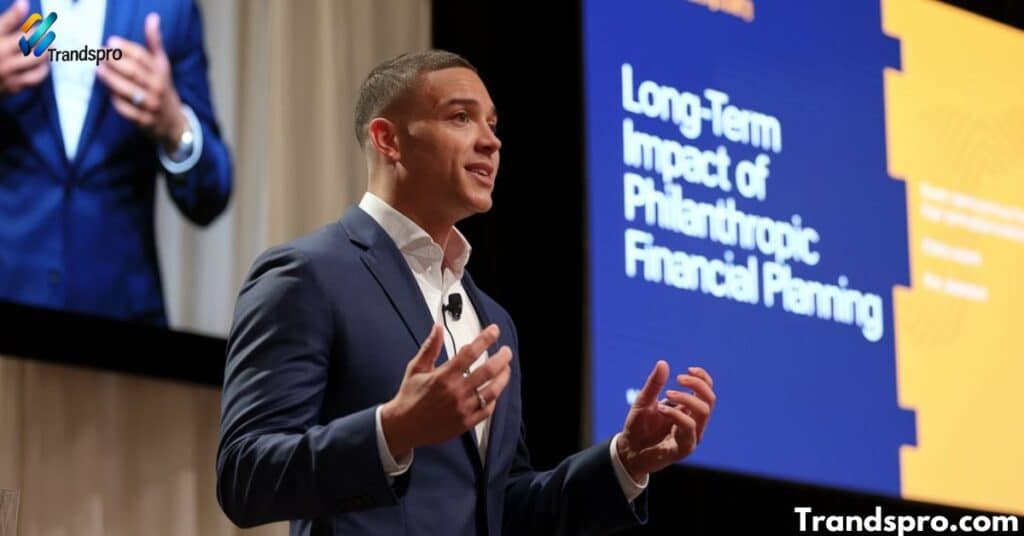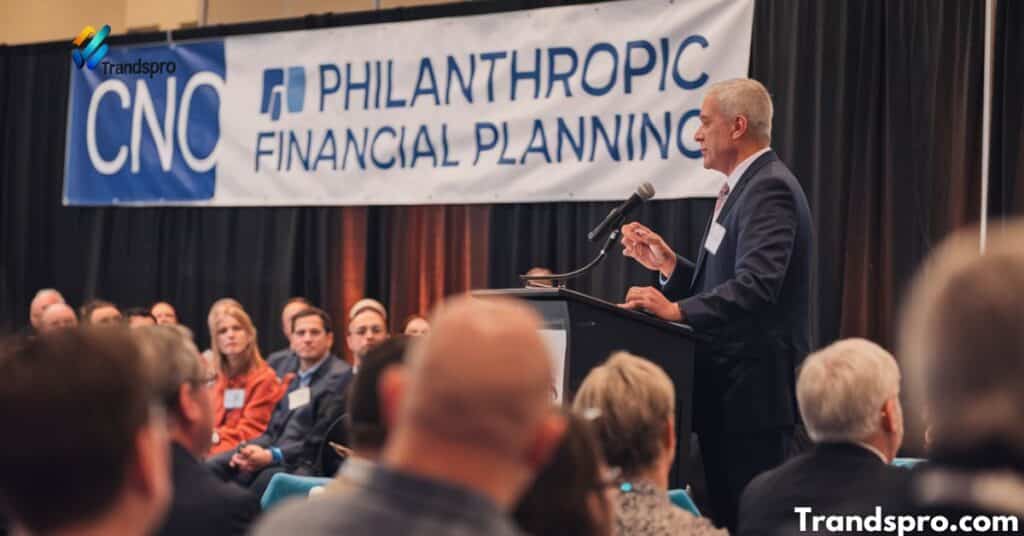In the ever-evolving world of nonprofit management, Chief Nonprofit Officers (CNOs) are tasked with balancing complex financial responsibilities while advancing their organizations’ charitable missions. CNO philanthropic financial planning is crucial in harmonizing these dual objectives, ensuring that financial strategies not only secure organizational sustainability but also amplify philanthropic impact.
This guide provides an in-depth exploration of CNO philanthropic financial planning, offering actionable insights, strategies, and best practices to enhance both financial and charitable outcomes.
Understanding CNO Philanthropic Financial Planning
CNO Philanthropic Financial Planning combines charitable giving with financial management. It helps people and organizations use their money to support causes they care about while ensuring their own financial security. This approach integrates philanthropy into broader financial strategies, aiming for both personal and societal benefits.
By incorporating charity into financial planning, individuals can enjoy tax benefits and a sense of fulfillment. This method ensures that financial goals align with philanthropic values, making a positive impact on both personal finances and the community.
Definition and Significance

CNO philanthropic financial planning involves the strategic management of finances with a focus on charitable goals. For CNOs, this means integrating personal financial planning with the nonprofit’s financial needs and charitable aspirations. This integration is essential for:
- Maximizing Impact: By aligning financial decisions with charitable goals, CNOs can significantly enhance the effectiveness of their nonprofit’s initiatives.
- Ensuring Financial Stability: A well-crafted financial plan helps secure the nonprofit’s long-term sustainability while meeting personal financial objectives.
- Enhancing Donor Confidence: Effective financial management demonstrates transparency and accountability, fostering trust and engagement from donors and stakeholders.
Importance of a Strategic Approach
CNOs face a unique set of challenges in managing nonprofit finances. Unlike for-profit entities where financial success is measured by profit margins, nonprofits must navigate the complexities of fundraising, budget management, and impact measurement. A strategic approach to philanthropic financial planning helps CNOs:
- Align Financial and Charitable Goals: Ensuring that personal and organizational financial strategies are in harmony with philanthropic objectives.
- Improve Financial Outcomes: Implementing effective planning can lead to better financial management and more impactful charitable contributions.
- Facilitate Growth and Sustainability: Strategic planning supports the long-term growth and sustainability of both personal finances and the nonprofit organization.
The Role of Philanthropy in Financial Planning
Philanthropy enriches financial planning by aligning charitable goals with personal financial strategies. Incorporating donations into financial plans can provide tax benefits and create a sense of personal fulfillment. This approach helps individuals and organizations make a positive impact while ensuring their own financial stability.

By integrating philanthropy into financial strategies, people can support causes they care about without compromising their financial goals. It allows for a well-rounded approach that combines financial security with meaningful contributions, leading to a balanced and impactful financial plan.
Integration into Financial Strategies
Integrating philanthropy into financial planning involves more than just allocating funds to charitable causes. It requires a holistic approach to ensure that philanthropic goals support, rather than hinder, overall financial objectives. Key aspects include:
- Aligning Charitable and Financial Goals: Ensuring that charitable ambitions are integrated with financial strategies to create a cohesive plan.
- Strategic Allocation of Resources: Allocating funds in a manner that maximizes both financial returns and charitable impact.
Benefits of Philanthropy Integration
The integration of philanthropy into financial planning offers several significant benefits:
- Enhanced Charitable Impact: Aligning financial strategies with charitable goals ensures that contributions have a more substantial and measurable effect.
- Increased Stakeholder Engagement: Demonstrating a commitment to effective financial and philanthropic management can lead to greater trust and engagement from donors and stakeholders.
- Tax Advantages: Strategic charitable giving can provide various tax benefits, optimizing overall financial health and reducing taxable income.
Understanding Nonprofit Financial Management
Effective nonprofit financial management is crucial for ensuring that funds are used efficiently and transparently. Here’s a closer look at key components:
Budgetary Management
Budgetary management in nonprofits involves several critical elements:
- Allocating Resources: Strategically distributing funds to support the nonprofit’s mission, program s, and operational needs.
- Monitoring Expenses: Keeping track of expenditures to prevent overspending and ensure financial stability.
- Financial Reporting: Providing clear, accurate, and transparent financial reports to stakeholders, including donors, board members, and regulatory agencies.
Key Aspects of Budgeting
Effective budgeting for nonprofits requires attention to several factors:
- Revenue Streams: Identifying and diversifying sources of income, such as donations, grants, and fundraising events, to ensure financial stability and sustainability.
- Expense Tracking: Maintaining detailed records of all expenditures to manage finances effectively and make informed decisions.
- Forecasting: Projecting future financial needs and preparing for potential shortfalls or surpluses, ensuring that the nonprofit can navigate financial challenges effectively.
Investment Methods
Investing funds wisely is essential for growing resources and supporting long-term sustainability:
- Endowments: Establishing endowments to provide ongoing financial support, ensuring that the nonprofit has a reliable source of income.
- Short-Term Investments: Utilizing less risky investments to manage immediate liquidity needs, providing flexibility and security.
- Social Impact Investing: Investing in projects or companies that align with the nonprofit’s mission, creating both social and financial returns.
Risk Reduction
Managing risk is crucial in financial planning to maintain stability and prevent losses:
- Diversification: Spreading investments across various asset classes to minimize risk and avoid potential losses.
- Insurance: Securing appropriate insurance to protect against unforeseen financial losses and liabilities.
- Financial Controls: Implementing strict financial controls to prevent fraud, mismanagement, and ensure accurate financial reporting.
Financial Planning Strategies for CNOs
Financial planning strategies for CNOs (Chief Nursing Officers) focus on balancing professional responsibilities with personal financial goals. These strategies often include budgeting for both current and future needs, investing wisely, and managing risks. CNOs can benefit from creating a comprehensive financial plan that addresses retirement savings, insurance, and tax planning.

Effective financial planning also involves setting clear objectives for both personal and philanthropic goals. By integrating charity into their financial strategies, CNOs can support causes they care about while ensuring their own financial security. This holistic approach helps them achieve a balanced and fulfilling financial future.
Retirement Planning
Effective retirement planning is essential for ensuring financial security in later years:
- Retirement Accounts: Utilize accounts such as IRAs and 401(k)s to build a secure retirement fund. These accounts offer tax advantages and help accumulate savings over time.
- Pension Plans: Understand the benefits and limitations of pension plans if offered by the nonprofit. Ensure that these plans are integrated into your overall retirement strategy.
- Personal Savings: Build a robust personal savings strategy to complement retirement accounts and ensure a comfortable retirement.
Aligning Altruistic Values with Financial Objectives
Balancing personal financial goals with philanthropic ambitions requires a strategic approach:
- Setting Clear Goals: Define both financial and charitable objectives to guide decision-making and ensure alignment between personal and organizational goals.
- Creating a Balanced Plan: Develop a financial plan that integrates personal and organizational goals with charitable aspirations, ensuring that all objectives are addressed.
Creating a Philanthropic Budget
A well-structured philanthropic budget involves:
- Allocating Funds: Decide how much of the budget will be dedicated to charitable activities and allocate resources accordingly. This includes determining the proportion of personal income or organizational funds to be directed toward charitable causes.
- Monitoring Effectiveness: Track the impact of charitable contributions to ensure that funds are used effectively and make adjustments as needed to enhance the impact of giving.
Maximizing Charitable Giving
Maximizing charitable giving involves strategically planning donations to enhance their impact and benefit. This can be achieved through methods like setting up Donor-Advised Funds (DAFs), utilizing charitable trusts, and taking advantage of tax deductions. By planning contributions wisely, donors can support more causes and potentially increase the overall effectiveness of their giving.

Additionally, scheduling regular donations and participating in matching gift programs can significantly amplify the impact of charitable contributions. Effective planning ensures that donations align with personal values and financial goals, creating a lasting positive effect on both the community and the donor’s financial well-being.
Tax Benefits of Charitable Giving
Charitable giving can offer several tax advantages:
- Deductibility: Many charitable donations are tax-deductible, reducing taxable income and lowering overall tax liability. This can lead to significant savings and optimize financial health.
- Charitable Trusts: Utilize Charitable Remainder Trusts (CRTs) and Charitable Lead Trusts (CLTs) to manage complex giving scenarios. These trusts provide benefits such as current tax deductions and potential income tax savings.
- Planned Giving: Structure future donations through wills or estate plans to benefit from tax advantages while supporting long-term charitable goals.
Donor-Advised Funds (DAFs)
DAFs offer flexibility and benefits for managing charitable contributions:
- Benefits: Allows donors to make a charitable contribution, receive an immediate tax deduction, and recommend grants to charities over time. DAFs offer a way to maximize the impact of charitable giving while retaining control over the timing and allocation of donations.
- Flexibility: Provides the ability to direct donations to specific charities at a later date, allowing for thoughtful and strategic giving.
Charitable Trusts
Charitable trusts can be structured to provide financial benefits to both the donor and charitable organizations:
- Charitable Remainder Trusts (CRTs): Provide income to the donor or other beneficiaries with the remainder going to charity. CRTs offer a current tax deduction and potential income tax savings while providing ongoing income to beneficiaries.
- Charitable Lead Trusts (CLTs): Provide income to a charity for a specified period, with the remainder going to non-charitable beneficiaries. CLTs can help reduce estate and gift taxes while supporting charitable causes.
Direct Donations and Matching Contributions
- Direct Donations: Contributing funds directly to charities is a straightforward way to support causes you care about. Direct donations can be made regularly or as one-time gifts, depending on personal preferences and financial capabilities.
- Matching Contributions: Leverage employer or donor matching programs to increase the impact of your donations. Many organizations offer to match employee donations, effectively doubling the contribution’s value and enhancing the overall impact.
Planned Giving
Planned giving involves structuring donations to maximize impact and benefits:
- Bequests: Include charitable donations in your will to support causes after your death. Bequests can be a significant way to leave a lasting legacy and support charitable organizations.
- Life Insurance: Name a charity as a beneficiary of a life insurance policy to provide significant future support. This strategy can help create a substantial gift while offering tax benefits.
Advanced Philanthropic Financial Planning Techniques
Advanced philanthropic financial planning techniques involve sophisticated strategies to enhance the impact of charitable giving while optimizing financial outcomes. Techniques such as establishing Charitable Remainder Trusts (CRTs) or Charitable Lead Trusts (CLTs) allow for substantial contributions while providing tax benefits and potential income streams.

Donor-Advised Funds (DAFs) offer flexibility and control over charitable donations, enabling donors to make contributions and recommend grants over time.
Additionally, utilizing strategies like planned giving and incorporating philanthropy into estate planning ensures that charitable goals are met while maintaining long-term financial stability. These advanced techniques help donors maximize their charitable impact while aligning with their overall financial plans.
Prepared Giving Techniques
To further enhance philanthropic impact, consider these advanced techniques:
- Structured Gifts: Plan and structure gifts to be given at specific times or under certain conditions to maximize impact. Structured gifts can be tailored to meet both personal and organizational needs.
- Philanthropic Investment Case Studies: Analyze successful philanthropic financial planning case studies to learn from best practices and strategies. Understanding how other organizations and individuals have achieved their philanthropic goals can provide valuable insights.
Case Studies
Examining real-world examples offers practical insights and lessons:
- Successful Strategies: Review case studies of effective philanthropic financial planning to understand successful approaches and tactics. Case studies can illustrate how strategic planning and innovative approaches have led to significant charitable impact.
- Learning from Failures: Analyze challenges and setbacks in philanthropic planning to improve strategies and avoid common pitfalls. Understanding what went wrong in past endeavors can help refine current practices and enhance future outcomes.
Long-Term Impact of Philanthropic Financial Planning
The long-term impact of philanthropic financial planning can be profound, extending benefits well beyond immediate charitable contributions. By strategically integrating philanthropy into financial plans, individuals and organizations can create lasting positive changes in their communities. This approach not only supports crucial causes but also ensures sustained funding for initiatives over time.

Incorporating philanthropy into long-term financial strategies can lead to significant tax advantages and estate planning benefits. It helps establish a legacy of giving that can inspire future generations and contribute to societal progress.
Properly planned philanthropy ensures that financial resources are used effectively, amplifying the impact of charitable efforts and securing a lasting, meaningful contribution to the causes one values.
Sustainability
Strategic philanthropic planning not only benefits immediate needs but also ensures long-term success:
- Long-Term Vision: Develop a long-term vision for charitable impact, ensuring that financial strategies support sustainable giving. A long-term perspective helps align current actions with future goals and ensures continued support for charitable causes.
- Ongoing Management: Continuously manage and adjust financial plans to maintain sustainability and adapt to changing circumstances. Regular reviews and updates to the financial plan are essential for maintaining effectiveness and addressing new challenges.
Future Trends
Stay informed about emerging trends in philanthropic financial planning:
- Social Impact Investing: Explore opportunities for investing in projects that offer both social benefits and financial returns. Social impact investing can provide a way to support charitable causes while generating financial returns.
- Technological Innovations: Utilize new technologies to enhance charitable efforts and streamline financial management. Innovations such as online fundraising platforms and financial management software can improve efficiency and effectiveness in philanthropic planning.
Enhancing the Effectiveness of Philanthropic Financial Planning
Enhancing the effectiveness of philanthropic financial planning involves using strategic approaches to maximize the impact of charitable contributions. This can be achieved by employing tools like Donor-Advised Funds (DAFs) and charitable trusts, which offer flexibility and tax benefits while allowing for thoughtful allocation of funds over time.

Additionally, regularly reviewing and adjusting your financial plan to align with evolving philanthropic goals can improve effectiveness. Engaging with financial advisors and charitable experts can provide insights and strategies to ensure that your giving is both impactful and financially beneficial.
By integrating these methods, you can enhance the reach and effectiveness of your philanthropic efforts while maintaining a strong financial foundation.
Best Practices
To make philanthropic financial planning more effective, consider these best practices:
- Regular Reviews: Periodically review and adjust your financial and philanthropic strategies to ensure alignment with goals and changing circumstances. Regular assessments help identify areas for improvement and ensure that strategies remain relevant.
- Consult Financial Advisors: Work with financial advisors who specialize in nonprofit and philanthropic planning to refine your approach and maximize impact. Professional guidance can provide valuable insights and help navigate complex financial decisions.
Tools and Resources
Utilize various tools and resources to enhance philanthropic financial planning:
- Financial Planning Software: Utilize software tools to track and manage charitable contributions and financial planning. Software solutions can provide real-time insights and facilitate more effective management of finances.
- Educational Resources: Stay informed through seminars, webinars, and professional publications to keep up with the latest trends and best practices. Continued learning helps refine strategies and stay ahead of emerging developments.
Additional Resources
- Related Articles: Explore further reading on topics such as financial planning for nonprofits, philanthropy integration in financial plans, and charitable giving strategies to deepen your understanding and expand your knowledge.
- References: Consult additional resources for more detailed information on CNO financial planning, charitable trusts, and investment strategies for philanthropy. Accessing a variety of references can provide a more comprehensive view and support effective planning.
By applying these principles and strategies, CNOs can enhance their philanthropic efforts and ensure that their financial planning supports both personal and organizational goals. A thoughtful and well-executed approach to philanthropic financial planning not only benefits the nonprofit sector but also contributes to a more impactful and sustainable charitable environment.
Conclusion
Effective CNO philanthropic financial planning requires a comprehensive approach that integrates financial management with charitable goals. By understanding and implementing the strategies outlined in this guide, CNOs can achieve both personal financial security and significant charitable impact.
Strategic planning, combined with the use of advanced tools and techniques, enables CNOs to enhance their philanthropic efforts and ensure that their financial planning supports both their personal and organizational objectives.
>>>Read Also: 160+ Funny Bear Puns and Jokes: Bear-illiant Humor
Latest Article

Dave is the site admin for “trandspro.com” and specializes in writing within the journal category. If you need more detailed information about his background or work, feel free to ask!








